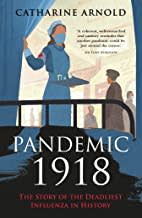Pandemic 1918
Catharine Arnold

In the dying months of WW1, Spanish flu overwhelmed the world, killing 50 million people. Germans soldiers termed it Blitzkatarrh, British soldiers called it Flanders Grippe, but globally the pandemic gained the notorious title of ‘Spanish Flu.’ The name itself is misleading; Spain, as a neutral county in WWI, was not subject to military censorship, and so the flu epidemic was reported there, and discussed in the leading medical journals of the day. In Britain and the United States, the very existence of ‘Spanish flu’ was concealed in order to protect morale.
But nowhere escaped this common enemy: the United States recorded 750,000 deaths, five times its total military fatalities in the war, while European deaths totalled over two million. In England and Wales, 250,000 people died in horrific conditions: onset was sudden and indicated by horrific symptoms including haemorrhages from the lungs and nose, the skin turning blue from lack of oxygen and choking to death from ‘air hunger’ as the lungs filled with blood and pus. Another weird symptom was that patients’ hair often turned white overnight. Those who never regained consciousness were the lucky ones; others died raving, lack of oxygen to the brain causing a form of dementia.
One of the most terrifying aspects of Spanish flu was the age of its casualties. The majority of the victims were healthy young men and women in the prime of life. The virus was particularly deadly because it triggered a cytokine storm, an auto-immune reaction which ravages the stronger immune system of young adults.
Against the background of the global epidemic, we meet the men and women who battled against this invisible enemy, from medical experts such as US Surgeon General Vaughan, pathologist William Henry Welch, Manchester’s Chief Medical Officer of Health Dr James Niven, and bacteriologist August von Wassermann, inventor of the famous ‘Wassermann test’ for syphilis, who was so determined to find a way to stop the epidemic in its tracks that he declared: ‘For me there are no Germans, no Englishmen – only men who suffer and must be helped.’
Those caught up in the epidemic including British Prime Minister David Lloyd George, US President Woodrow Wilson, and writers Robert Graves, Vera Brittain and Katherine Anne Porter. Alongside these richly distinctive characters appear brief glimpses of other lives: the army nurse who recalled the appalling stench of the sick and the dying: ‘I never smelt anything like it before or since. It was awful, because there was poison in this virus.’ The young bride who was buried in the same church that she had been married in, just a week earlier. The little boy who recalled ‘playing’ on the pinewood coffins piled up outside the undertakers’ store as the children all chanted the same rhyme:
I had a bird
Its name was Enza
I opened the window
And in flew Enza
Book Details:
- Author: Catharine Arnold
- On Submission
-
Rights Sold
- UK: Michael O'Mara
- USA: St Martin's Press
- Korea: Golden Time
- China: Shanghai Educational Publishing House Co
- Russia: Eksmo
- Saudi Arabia: Sumo

Catharine Arnold
Catharine Arnold read English at the University of Cambridge and holds a further degree in psychology. Catharine is best known for her London quartet, published by Simon & Schuster and comprising Necropolis, London and its Dead, Bedlam, London and its Mad, City of Sin, London and its Vices and Underworld London, City of Crime. She is also the author of Globe, the World of Shakespeare's London (Simon & Schuster, April 2015) and Edward VII, the Prince of Wales and the Women He Loved, St Martin’s Press, 2017. Catharine’s latest book is Pandemic 1918, the Story of the ...
More about Catharine Arnold
Book Reviews
-
"Fascinating... lurid and pacy... the page-turning fascination of a detective thriller ."
BBC History Magazine -
"Catharine Arnold has done a remarkable job of relating the tales of a diverse set of sufferers, crafting an arresting and intimate narrative of the 1918 pandemic... a gripping tale that swoops down into the grisly detail, then soars up to give a broad view over the landscape of this calamitous moment in human history... Arnold writes beautifully, and starkly, of the tragedy that unfolded ."
New Statesman -
"Arnold's pacey history focuses on the stories of the individual, from scientists and politicians to the ordinary men and women who suffered ."
History Revealed -
"This timely study prompts us to reflect with gratitude on the advances of modern medicine."
The Lady -
"Catharine Arnold's book offers us a coherent, well-researched and sanitary reminder that another pandemic could be just around the corner with equally horrific consequences. "
Sir Tony Robinson -
"A lively catalogue of events and key figures in the course of the pandemic... what captivates most are the accounts of witnesses and survivors... it is often easy to forget about those left behind, but Arnold has given them a voice."
The Lancet -
"Meticulously researched . . . vividly conveys the terror of the disease."
Professor Sheena Cruickshank, -
"Catharine Arnold is a master storyteller. I couldn't put it down."
Lindsey Fitzharris -
"(Catharine Arnold) is good at looking at civilians as well as troops and their nurses and doctors and at teasing out the human side of the catastrophe… powerful stories of ordinary people."
Wall Street Journal -
"Historian Arnold presents a collection of essays that colorfully illustrate the everyday impact of the disease...an enjoyable read."
Library Journal (starred review) -
"This well-researched and often overwhelming history serves as a stark warning of the threat of pandemic flu."
Publishers Weekly (starred review) -
"A wealth of stories..well-researched."
Kirkus Reviews -
"Detailed and chilling…Arnold gives firsthand accounts from those who witnessed and survived the Spanish flu’s deadly grip while examining its impact."
Bookpage